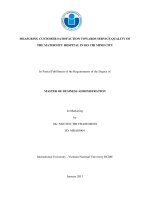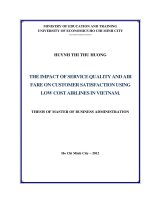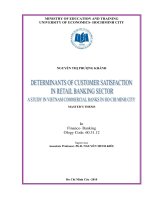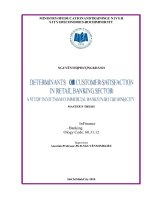Measuring customer satisfaction using retail internet banking service a sacombank
Bạn đang xem bản rút gọn của tài liệu. Xem và tải ngay bản đầy đủ của tài liệu tại đây (1.15 MB, 86 trang )
TRNG I HC M TP.HCM UNIVERSITÉ LIBRE DE BUXELLES
HO CHI MINH CITY OPEN UNIVERSITY SOLVAY BRUSSELS SCHOOL
MBAVB3
NGUYEN THI HUYEN ANH
MEASURING CUSTOMER SATISFACTION USING
RETAIL INTERNET BANKING SERVICE AT
SACOMBANK
MASTER PROJECT
MASTER IN BUSINESS ADMINISTRATION
(PART TIME)
Tutor’s name: Dr. NGUYEN KIM THU
Ho Chi Minh City
(2010)
DECLARATION
I declare that this final project contains no material that has been submitted to any
other program in other institutes, colleges and universities. This work was done by
author except where due reference is made in the text.
Signature: NGUYEN THI HUYEN ANH _____________________
Date:__________________________________________________
ACKNOWLEDGEMENTS
First of all, I would like to acknowledge all professors and coordinators who
provided me valuable knowledge and support at Solvay Business School and Ho
Chi Minh City Open University.
I would like to acknowledge my tutor, Dr Nguyen Kim Thu, for her assistance on
my research.
I would like to express my huge thanks to my parents and my sisters who support
me and encourage me to complete this research.
I would like to acknowledge Ms. Nguyen Thi Thuy Trang and Ms. Nguyen Thi Tra
My, Sacombank members, who help me to collect relevant information and
database.
I would like to thank my VB3 friends, who have been studying and sharing ideas
together for the whole course. In particular, I wish to acknowledge the support of
the following people who without their assistance, this project would not finish. Ms.
Duong Thi Kieu Chinh and Mr. Dang Tran Hanh Thong for their encouragement
and support, Ms. Phan Xuan Binh for her great assistance, her value feedbacks
help me to find out the way to complete the research. Thank you so much for your
kind assistance.
And, I would like to send my thanks to all respondents.
ABSTRACT
The Internet has revolutionized the way that businesses operate and the financial
world has not been spared (Hoffman et al. & Bateson et al., 2006). With the
appearance of internet, bank has no longer boundary to time or geography.
Customers can catch their banking account operations 24/7 via internet. In
Vietnam, internet banking is still at the beginning stage. To recognize that Vietnam
is potential market for internet banking (IB) with high internet users in Asia,
Vietnamese bankers have launched this service to the market. But in order to
success in banking services, bankers should understand how satisfied their
customers feel about their services. Kotler said that customer satisfaction is
associated with numerous positive business outcomes (1994). Until now, many
researches had been conducted to find out the reaching of customer satisfaction for
banks. But fewer researches have addressed the measuring customer satisfaction in
IB service. Hence, this empirical study aims to measuring customer satisfaction
from retail IB service and Sacombank’s IB customers were chosen as the
population.
The objectives of this project are (1) to measure the relative customer satisfaction
with retail IB service at Sacombank, (2) to identify the drivers of customer
satisfaction with retail IB service at Sacombank, (3) to find out which are the most
significant important in service and internet attributes impacting on customer
satisfaction and (4) to contribute recommendations to improve customer
satisfaction.
TABLE OF CONTENTS
CHAPTER 1 INTRODUCTION
1.1. INTRODUCTION 1
1.2. RESEARCH BACKGROUND 2
1.3. RESEARCH PROBLEM 6
1.3.1. RESEARCH OBJECTIVES 11
1.3.2. RESEARCH QUESTIONS 11
1.3.3. RESEACH MODEL 11
1.3.4. RESEARCH HYPOTHESIS 13
1.4. METHOD OF STUDY 13
1.5. SCOPE AND LIMITATION OF STUDY 14
1.6. FRAME WORK OF STUDY 15
CHAPTER 2 LITERATURE REVIEW
2.1. INTRODUCTION 17
2.2. INTERNET BANKING 17
2.3. SERVICE QUALITY AND INTERNET QUALITY 18
2.3.1. SERVICE QUALITY 18
2.3.2. INTERNET QUALITY (WEBSITE QUALITY) 21
2.4. CUSTOMER SATISFACTION 22
2.5. THEORETICAL FRAME WORK 23
2.5.1. MEASUREMENT OF SERVICE QUALITY 23
2.5.2. MEASUREMENT OF INTERNET QUALITY 25
CHAPTER 3 RESEARCH METHODOLOGY
3.1. INTRODUCTION 27
3.2. DESCRIPTION OF RESEARCH METHOD 28
3.2.1. QUALITATIVE RESEARCH 28
3.2.2. QUANTITATIVE RESEACH 30
3.2.3. MEASUREMENT OF VARIABLES 32
3.2.4. DATA COLLECTION 36
3.2.5. MEASUREMENT OF INSTRUMENTS 37
CHAPTER 4 FINDING ANALYSIS
4.1. INTRODUCTION 40
4.2. BRIEF INFORMATION ABOUT IB SERVICE AT SACOMBANK 40
4.3. DESCRIPTIVE FINDINGS OF THE RESEARCH 42
4.3.1. DESCRIPTIVE GENERAL INFOMATION 42
4.3.2. IB SERVICE 43
4.4. RELIABILITY ANALYSIS 45
4.5. FACTOR ANALYSIS 46
4.6. REGRESSION ANALYSYS 50
4.6.1. CORRELATION ANALYSYS AND FINDING 50
4.6.2. EVALUATING AUTHOR’S MODEL 51
CHAPTER 5 CONCLUSION & RECOMMENDATIONS
5.1. INTRODUCTION 56
5.2. RESEARCH SUMARY 56
5.2.1. SUMMARY RELATED TO RESEACH QUESTIONS 57
5.2.2. SUMMARY RELATED TO HYPOTHESES 58
5.3. RECOMMENDATIONS 59
5.4. IMPLICATIONS FOR FURTHER RESEARCH 61
GLOSSARY OF TERMS AND ABBREVIATIONS
ACB Asia Commercial Bank
IB Internet bank
Sacombank Sai Gon Thuong Tin Commercial Joints Stock Bank
VCB Vietnam Bank for Foreign Trade
LIST OF TABLES
Table 1.1: Vietnamese Internet users 4
Table 3.1: Number of IB customers on HCMC area 33
Table 3.2: Numbers of chosen customers in HCMC 34
Table 3.3 Coding variables 36
Table 4.1: Cronbach Alpha value of each factor 45
Table 4.2: Corrected Item-Total Correlation 46
Table 4.3: Correlation matrix 47
Table 4.4: KMO & Bartlett’s Test of Sphericity summary 49
Table 4.5: Pearson correlation (r) 51
Table 4.6: Model summary 52
Table 4.7: Anova (b) 52
Table 4.8: Coefficients (a) 53
Table 4.9: Hypothesis Assessment result 54
LIST OF FIGURES
Figure 1.1: Internet Penetration in Asia in 2009 (% of population) 4
Figure 1.2: IB’s users at Sacombank 10
Figure 1.3: Relationship of loyalty and satisfaction 10
Figure 1.4: Author’s research model 12
Figure 2.1: Factors impact on customer satisfaction 23
Figure 3.1: Research process of the study 28
Figure 4.1: Charter Capital in recent years 41
Figure 4.2: Total Asset in recent years 41
LIST OF CHARTS
Chart 4.1: Gender 42
Chart 4.2: Education 42
Chart 4.3: Frequency of using IB 44
Chart 4.4: Satisfaction 44
Chart 4.5: Service satisfaction 44
Chart 4.6: Internet satisfaction 44
1
CHAPTER ONE:
INTRODUCTION
1.1 INTRODUCTION
This chapter draws the overall picture of the research. It show the way of the project
by mentioning the problem statement, research objectives and questions. The
objectives of this chapter are (1) demonstrate research background, (2) explain the
research problem and research objectives and base on (2) to (3) develop research
questions and research model.
1.2 RESEARCH BACKGROUND
At the beginning, the primary activities of banking are keeping safe money with
interest and making liquidity for the economy by loaning the money. Bank is an
intermediated financial institution and plays a key drive in any national economy
and global economy as well. In scenario of competition, each bank has tried to serve
their customers more than their expected value. Internet has brought the new
entrants for banking to change the structure of banks (Laura & Kate, 2003) in
general and banking service in particular. The wide application of internet promoted
producers and entrepreneurs to sell their products and service online. Taking the
advantages of this technology, internet banking was born to provide added values to
2
customers. Internet banking is predicted to transform and revolutionized banking
industry (Mols, 1999; Daniel, 1999).
In 80’s decade, four banks include Citibank, Chase Manhattan, Chemical and
Manufacturers Hanover launched home banking service through a videotext system
to New York market. Home banking service, however, had never penetrated
banking segment (Mary J. C). After that, online banking service was introduced in
Oct 1994. The service was developed by Standford Federal Credit Union, which is a
financial institution.
Internet banking was concerned with all type of banking transactions to be taken
place on internet through a personal computer (PC) or other intelligent device. To
classify by kinds of customers, Internet banking products and services could be
divided into two kinds wholesale and retail. With internet banking, bankers could
easily save more cost, increase customers base, be enable mass customization,
conduct marketing and communication, be enable innovation, develop non-core
business (Comptroller’s handbook, 1999). Although the benefit of banking using IB
was huge, IB in Vietnam was still infancy at the beginning stage.
According to a study of Stegman (1999), to implement one banking-transaction by
traditional channel costs average 1.07 USD in USA. After applying internet
banking, the cost was 0.04 USD for call center; 0.27 USD for ATM; 0.01 USD for
Internet banking. It is obvious that offering IB, banks have a clearly cost advantage
compared to traditional transaction. To realize these benefits, bankers invest
billions of dollars in providing and improving the IB system for their customers
(Bauer, Hammerschmidt and Falk, 2005). In Pacific Asia, IB was launch in China,
3
HongKong, Singapore, Thailand, Malaysia etc. In Malaysia and China, IB was
official allowed by Centre Bank in 2000. Maybank is the first bank in Malaysia to
offer IB. However, Thailand and Singapore were applied IB a bit earlier since 1995
and 1997 by turns.
In Vietnam, Society of Worldwide Interbank Financial Telecommunication
(SWIFT) appeared in Vietnam in 1995 to support Vietnam’s banks. Interbank
Payment System which is a key component of banking industry’s modern future was
presented at Vietnam in 2002. Foreign and joint-venture banks are the pioneer to
apply e-banking in Vietnam market. Following up the foreign banks, in 2004, ACB
launched Home-banking which permits customers enable to do transaction via their
PC; VCB launched VCBmoney (Sai Gon Computer Times, Sep 2004). But these
online banking services served only a few companies at this time. Many enterprises
didn’t want to use IB or were afraid of using it because of flinching from security of
IT infrustructure, and lack of e-commerce law in Vietnam. Until the end of 2005, e-
commerce law was born. Two recent years, e-banking is more familiar with
Vietnam customers. Many Vietnamese banks have been investing into technology
infrastructure which aims to focus on “one-stop e-banking service” to serve their
potential customers. T24 core banking – Tenemos Swiss, the leading financial
banking software to be operating over 400 banks on over the world and Oracle
Flexcube core banking are modern technology system which Vietnamese banks
have been applied with investment expenses is up to millions dollars.
According to Investment News (2010), Vietnamese IB has three levels:
4
Level 1: supplying simply functions such as enquiring transactions, enquiring
outstanding balance current accounts.
Level 2: be added more functions compared to level 1 such as transferring
money to the same banking system and to other banking systems, paying
loan, opening LC etc
Level 3: supplying completely online banking and online payment such as
serving investment activities and other value-added services.
At present, most of Vietnamese banks supply IB at level 1 or level 2. Although IB
is at the beginning stage, there is a high rate of internet user. Vietnam is promised
to be the hot market due to growing sharply in the next few years affecting the
competitive advantage enjoyed by traditional banks with physical branch (Duclaux
1996; Liao et al., 1999)
Table 1.1: Vietnamese Internet users
Source: Internet World Stats
5
And according to Nielsen, the total number of internet users worldwide is
1,5796,108
(1)
. Comparing with the world, Vietnam ranked at 103
th
(7.7 users per
100 people) in 2004 and 92
sd
in 2008 (24.17 users per 100 people) about internet
users
(2)
. It is clearly that the more internet users the more convenience for banks to
expand their e-banking service.
Figure 1.1: Internet Penetration in Asia in 2009 (% of population)
Top 10 countries
Source: Internet World Stats (
www.internetworldstats.com)
1
NetRatings via Internet World Stats, April 2009
2
International Telecommunication Union, World Telecommunication Development Report
6
However, Nielsen also announced that only 1% Vietnamese population who using
banking services had used and enable to use the utilization of IB. Lack of awareness
about this channel (52%) and safety (28%) are some reasons that customers don’t
want to conduct IB (AC Nielsen 2010)
1.3 RESEARCH PROBLEM
RATIONALE OF THE STUDY
IB has been brought benefits both banker and customers. With IB, bankers use their
website to offer classical operations such as accounts balance detail or money
transfer, or to provide bill payment, credit card and investment advice and stock
trading (Guru et al., 2003). Website is a modern channel to provide information and
undertake customers’ transaction and it also is a tool to improve customer
relationship (Diniz, 1998). It help financial institutions to reduce costs as above
analysis, shorten processing periods, increase speed and improve the flexibility of
business transactions and provide better service overall (Ainin et al., 2005). Beside,
IB also allows customers to save time by undertaking their transactions 24 hours a
day without queuing for hours waiting at mortal branch banks; it allows customers to
reduce their bank’s costs because banks decrease the fees or charges due to their
reducing costs advantage. Due to the advantages of IB, the major banks offer IB
service. In the competitive context, it is easy to duplicate products and services
when banks supply mostly identical services, where customers are the key factor for
the success in term of profit and market shares. Customer satisfaction has been
being as attention of many organizations because the high customer satisfaction has
7
been linked to customer retention, market share, loyalty, higher company’s profits
(Szymankski and Henard, 2001).
From the first IB introduction, according to author’s knowledge, There has been a
little of researches which have examined the customer satisfaction. And these
authors have applied several theories to predict the factors influence in customer
satisfaction from using retail IB. The theories include: service quality of Parasuman
(Riquelme et al., Mekkaoui et al., and Rios et al., 2009). Hence, a research of IB
customer satisfaction is significant important to fulfill this gap.
RESEARCH PROBLEM
Sacombank is one of the first commercial banks in Vietnam was establish in 1991.
Its charter increases to 9,179 billion dong in 2010. The bank has 320 transaction
points in 45 of the 63 provinces and cities in the country and has also established
international operations in Laos and Cambodia.
Sacombank’s brand name and reputation has been recognized by Vietnam
community through prestigious awards as “Yearly Retail Banking in Vietnam 2007,
2008” be voted by Asian Banking and Finance, “The best local Bank in Vietnam
2008” be voted by The Asset, Global Finance and Finance, “The best foreign
exchange business bank in Vietnam 2009”.
To be competitive and compete effectively in long run, Sacombank invested in
modern IT infrastructure supplied by reputed partners such as: Tenemos, Oracle,
Cisco, IBM, HP etc. Its modern technology comprises: main applied server – IBM
p595, main database server – HP Superdome, database – Oracle and Storage
8
system SAN XP24000… These systems which are modern international standard
were installed in Sacombank’s data center. Based on high tech systems, to improve
competitiveness and management capacity to serve customers better and better,
Sacombank has been conducted deploy new applications to improve
competitiveness and administrative capacity. Projects which have been
implemented are E-banking, Data Warehouse, Customer Relationship
Management, Management Information System, Treasury, Contact Center, Risk
Management, and Human Resource Management …
For retail segment, Sacombank presently supplies more than 120 products and
services which are cards, mobilizing capital, credit, internet banking, other
individual financial service and products linked with bancassurance insurance.
Sacombank firstly introduced IB in 25/05/2011. To end of 2010, there was over
8,000 individual users using IB. With retail IB service of Sacombank, customers
don’t need to go to the bank “brick and mortar” but enable to implement their
transactions at anywhere with their PC/laptop or intelligent devices which connect
internets “click and mortar”.
In Vietnam banking industry, today, it is easy to duplicate products and services
when banks supply mostly identical services. To create the differentiation,
Sacombank does its own way by supplying qualified service and applying customer
contact to take care customers. Sacombank puts customer satisfaction in the top
concern.
However, Sacombank has faced the problem that the speed of increasing
percentage of IB customers was rather low than estimated plan. The figure 1.2
9
below demonstrates that the development of IB users was low increasing in the last
three months of 2010. The expected speed of increasing IB was 25% at the end of
2010 compared with September, 2010. The estimated plan was reasonable because
the huge demand to use IB service at Sacombank which was got from the previous
study with exist retail customers.
Beside, according internal report, the critical point that Sacombank has faced that
there were customers complaints which focused on (1) IB service qualification such
as late transferring money transactions, unprofessional consultant staffs, busy
contact center, inconsistency instruction between consultant staff at branch and
contact center and (2) internet qualification such as difficult in logging in account,
embarrass interface etc.
The project aims to measure the customer satisfaction from using retail IB by
examining customer satisfaction via service and internet quality dimension. From
measuring customer satisfaction, Sacombank would improves its’ customer
satisfaction by suitable approaches. And it could get customer retention because
satisfied customers are more loyal than unsatisfied customers (figure 1.3).
10
Figure 1.2: IB’s users at Sacombank
Source: Internal source of Sacombank
Figure 1.3: Relationship of loyalty and satisfaction
Source: James L.Heskett.W.Earl Sasser, Jr., and Leonard A.Schlessinger, The
service profit chain (New Y ork, NY : The Free Press, 1997).p.83
11
1.3.1 RESEARCH OBJECTIVE
The purpose of this study was to exam the level of customer satisfaction from using
IB of Sacombank. The specific objectives were as follows:
- To measure the relative customer satisfaction with retail IB service at
Sacombank;
- To identify the drivers of customer satisfaction with retail IB service at
Sacombank;
- To find out which are the most significant important in service and internet
attributes impacting on customer satisfaction;
- To contribute recommendations to improve customer satisfaction.
1.3.2 RESEARCH QUESTIONS
The survey was conducted to answer below questions:
Question 1
: What are the customers’ perceptions impacting on satisfaction over the
internet and service quality dimensions?
Question 2
: How well do eight dimensions predict customer satisfaction?
Question 3
: What is the most important critical predictor of customer satisfaction?
1.3.3 RESEARCH MODEL
Base on the research (1) of Riquelme et al., Mekhaoui et al., ans Rios et al (2009)
“Internet banking customer satisfaction and Online service attributes” and the
12
research (2) of Minjoon J, Shaohan C (2009) “the key determinant of internet
banking service quality”, research (1) presents about relationship of customer
satisfaction with service attributes and online attributes and research (2) displays the
key determinant of internet banking service quality. To simplify base on these
researches, below is author’s model.
Figure 1.4: Author’s research model
13
1.3.4 RESEARCH HYPOTHESIS
To explore research questions and related questions (if any), here are research
hypotheses:
Hypothesis H1
: There is a positive impact of “reliability” on “customer
satisfaction".
Hypothesis H2
: There is a positive impact of “responsiveness” on “customer
satisfaction”.
Hypothesis H3
: There is a positive impact of “courtesy” on “customer satisfaction”.
Hypothesis H4
: There is a positive impact of “access” on “customer satisfaction”.
Hypothesis H5
: There is a positive impact of “ease of use” on “customer
satisfaction”.
Hypothesis H6
: There is a positive impact of “content” on “customer satisfaction”.
Hypothesis H7
: There is a positive impact of “timeliness” on “customer
satisfaction”.
Hypothesis H8
: There is a positive impact of “security” on “customer satisfaction”.
1.4 METHOD OF STUDY
The quantitative research was applied in the study to exam the model by analyzing
the reliability and testing hypotheses. Self-administrated questionnaires were sent
14
to Sacombank’s retail IB customers to collect primary data. Respondents were
selected
from Sacombank’s database. The survey was implemented from 10
th
December, 2010 to 31
st
January, 2011. 676 questionnaires were emailed to
respondents. After collecting the customer feed backs, SPSS was used to process
data.
1.5 SCOPE AND LIMITATION OF STUDY
IB for retail segment brings potential to both banks and customers by its
conveniences. Although, IB remains immature in Vietnam, there is a phenomenon
that many Vietnamese banks launch IB to the market. To get customers satisfaction
is the most concern in banking industry. With this project, the result and analyses
are significant with Sacombank to improve its customer satisfactions by efficient
approaches.
Due to the limited time and resources, the survey was conducted by email
questionnaire in HCMC only. Target population was IB experience customers and
169 respondents were rather small compared to other research in Hong Kong (632),
Kuwait (185) and Turkey (527). The number of respondents should be larger to
representative of IB in HCMC. And, the research could not reach customers in other
regions of Vietnam. Although the majority of IB customers concentrate in HCMC,
however it maybe customers at other region have different assessment about
satisfaction from IB.









